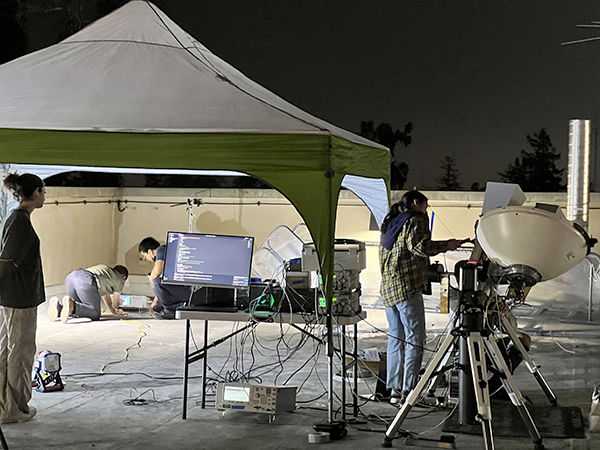A Glimpse at the Future of Space-Based Solar Power

As electric cooperatives look ahead to the future of energy infrastructure, a new and unexpected frontier is emerging. Space-based solar power (SBSP) is being explored by leading scientists and defense agencies as a long-term solution to deliver clean, continuous energy from orbital solar arrays back down to Earth.
“Although the technology is still in its very early stages and far from commercial viability, recent breakthroughs suggest a future where solar energy can be collected above the atmosphere and transmitted wirelessly to the ground,” CFC Director of Utility Research & Policy Brian Sloboda said. “This concept could also lead to new forms of terrestrial energy transmission, eliminating the need for traditional wires.”
What Is Space-Based Solar Power?
SBSP involves placing solar panels on satellites in geostationary orbit, where they can collect solar energy 24 hours a day. This energy is then converted into microwave or laser signals and beamed to receiving stations on Earth, where it is transformed back into electricity and fed into the grid.
The idea originated in the 1960s but for decades was seen as too expensive and technically difficult. However, improvements in lightweight materials, wireless transmission and satellite technology have sparked engineers and policymakers to take a second look at the technology.
University, government and military labs are leading the way with recent developments:
Caltech’s Milestone
In 2023, the California Institute of Technology (Caltech) took a major step forward through its Microwave Array for Power-transfer Low-orbit Experiment, which became the first device to wirelessly transmit power in space and send a detectable signal to Earth. While only a small amount of power was transmitted, the successful demonstration proved that key parts of the SBSP concept can work in real-world conditions.
NASA and Ascent Solar’s Thin-Film Arrays
NASA, working with X-Arc and Ascent Solar, is advancing another critical component of SBSP: ultralight solar arrays made from thin-film materials. These panels are flexible, durable and significantly lighter than traditional solar modules. That reduction in weight is essential for space-based applications, where every kilogram adds to launch costs. The use of thin-film technology could make large-scale space solar farms more feasible.
Orbital Power for Forward Operating Bases
The Air Force Research Laboratory is developing Arachne, a space flight experiment under the Space Solar Power Incremental Demonstrations and Research program. Arachne will test advanced solar-to-radio frequency conversion using modular “sandwich tiles” and aims to demonstrate the feasibility of beaming solar energy collected in space to Earth, supporting energy delivery to military forward operating bases in contested environments.
DARPA’s POWER Program: Earth-Based Applications
While SBSP remains decades away from being commercially deployed, the U.S. Department of Defense is pursuing wireless power transmission here on Earth. DARPA’s Persistent Optical Wireless Energy Relay (POWER) program recently set a distance record by beaming 800 watts of power more than one kilometer using laser technology.
The system is being developed to deliver energy to remote or disaster-stricken areas where conventional infrastructure is unavailable. In the future, this kind of power beaming could also offer solutions in rough terrain where laying wires is difficult or expensive. Although it is not yet scaled to support the needs of a large utility, the technology shows promise for military and emergency applications.
“Despite the excitement, space-based solar power is still not close to being ready for widespread use,” Sloboda said. “Hurdles include low efficiency, atmospheric interference, safety and regulatory issues and high costs.”
- Low efficiency: Beaming power via microwaves, radio waves or lasers over long distances results in significant energy losses.
- Atmospheric interference: Earth’s atmosphere can distort or absorb portions of the transmitted energy.
- Safety and regulatory issues: High-powered beams may pose health and security risks and will need strict regulation.
- High costs: Launching and maintaining satellites remains expensive, though costs are decreasing due to private space companies like SpaceX.
According to a 2021 report by the European Space Agency, SBSP might become viable in the 2040s, but only with sustained investment and strong public-private cooperation.
What Electric Cooperatives Should Know
Although SBSP is not likely to affect your operations in the short term, there are several reasons to pay attention:
- Long-range planning: SBSP could eventually provide clean, stable baseload energy that is immune to weather or time-of-day limitations.
- Emergency response: Terrestrial wireless power systems, like DARPA’s POWER program, could be used to deliver electricity quickly to communities affected by natural disasters.
- Technology awareness: Keeping up with emerging energy technologies allows cooperatives to anticipate changes and explore future opportunities for innovation.
“Electric cooperatives have always been at the forefront of innovation, from rural electrification to broadband access,” Sloboda said. “SBSP, while not yet practical, represents the kind of forward-thinking approach that could transform how we generate and deliver electricity. By following technology developments and advancements, such as DARPA’s POWER program, cooperatives can prepare for a future where energy is not only produced in new ways, but also delivered by methods that defy today’s expectations.”
Further Reading:
- Caltech Space Solar Power Project
- DARPA POWER Program
- NASA’s X-Arc Thin-Film Innovation
- First Space-to-Earth Power Beam
- U.S. Air Force ARACHNE
